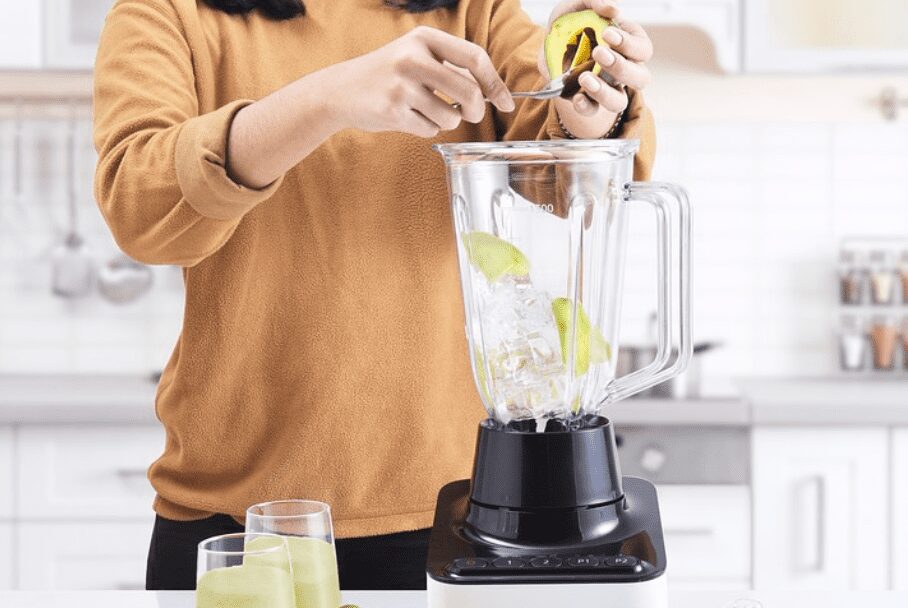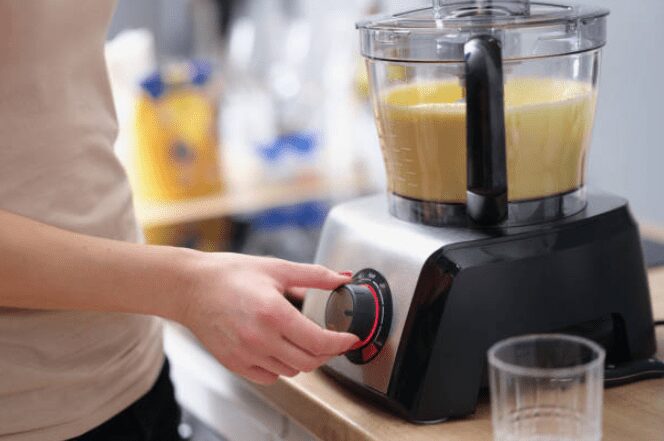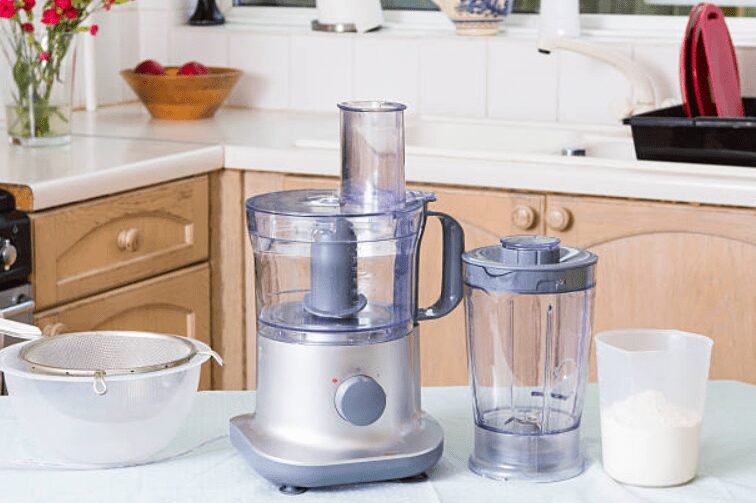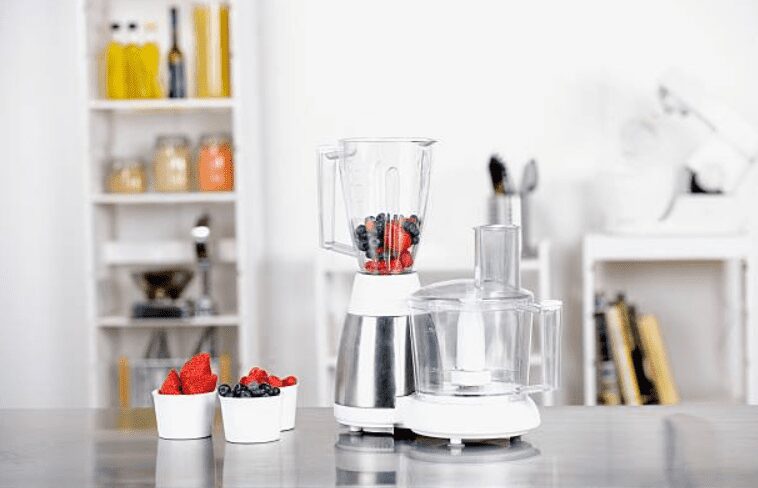A food processor and a blender are both kitchen appliances that are used to make food preparation easier, but they have different functions and are better suited for different types of food.
A food processor is designed to chop, slice, grate, and mix solid foods. It typically has a wide bowl with a flat blade that rotates at high speed to chop and mix ingredients. A food processor is ideal for tasks such as making dough, chopping vegetables, shredding cheese, or grinding nuts.
A blender, on the other hand, is designed to blend and puree liquids and soft foods. It typically has a tall, narrow container with a blade that is positioned at the bottom. Blenders are ideal for making smoothies, pureeing soups, or crushing ice.
Depending on the model, every blender and food processor is unique and could come with a variety of variable attachments. When comparing food processors vs blenders, you can typically rely on the following additional factors.
Continue reading to learn more about the differences between a food processor and a blender, as well as when you should use each to get the best results. While learning new techniques and recipes, this article will assist you in selecting the ideal tool for the job.
What Is A Blender?

A blender is a kitchen appliance used to blend, mix, and puree food and liquids. It typically consists of a motorized base, a container made of glass, plastic, or stainless steel, and a lid with a removable center to allow ingredients to be added while blending. The motor is housed in the base and drives a blade assembly located at the bottom of the container. When the motor is turned on, the blades spin rapidly, chopping and mixing the ingredients inside. Blenders are commonly used to make smoothies, soups, sauces, dips, and other foods that require a smooth or even consistency.
Read more: Healthy Breakfast Smoothies
What Is A Food Processor?

A food processor is a kitchen appliance that is designed to assist with food preparation tasks such as chopping, grinding, pureeing, and mixing. It consists of a motorized base that houses a container or bowl with a blade or set of blades that can be rotated at high speeds to process the food.
Food processors typically come with a range of attachments and blades that can be used for different tasks, such as slicing and shredding vegetables, making dough, and whipping cream. Some food processors also have additional features like juicing, grinding coffee beans, or making nut butter.
Overall, a food processor is a versatile kitchen tool that can help to save time and effort in food preparation and provide consistent results.
Types of Blenders and Their Differences
There are several types of blenders, each with unique features and functions. Here are some of the most common types and their differences:
Countertop Blenders
These are the most common type of blenders, and they come in a range of sizes and capacities. They can be used for a variety of tasks, from blending smoothies and pureeing soups to crushing ice and making nut butter. Countertop blenders typically have large pitchers and powerful motors, making them ideal for larger batches and tougher ingredients.
Immersion Blenders
Also known as hand blenders or stick blenders, these are handheld devices with a blade on one end that can be immersed directly into a pot, bowl, or glass. They are ideal for blending small batches of soups, sauces, or smoothies, and they take up less storage space than countertop blenders.
Personal Blenders
These blenders are designed for single-serving smoothies and shakes. They typically have smaller pitchers or cups that attach directly to the blending unit, making them convenient for on-the-go use.
High-performance Blenders
These blenders are designed for heavy-duty blending tasks, such as making nut butter or grinding grains into flour. They often have powerful motors and durable blades that can handle tough ingredients and extended use.
Specialty Blenders
There are also blenders designed for specific tasks, such as making frozen drinks, crushing ice, or juicing fruits and vegetables. These blenders often have specialized blades or attachments that make these tasks easier and more efficient.
Generally, the main differences between blenders are their size, capacity, power, and intended use. Choosing the right blender depends on your specific needs and preferences.
Food Processor vs Blender: The Difference

A food processor and a blender are both kitchen appliances used to prepare food, but they differ in several ways, including their blades, work bowls vs jars, sizes, and capacity.
Blades
The blades of a food processor and a blender are designed differently. Food processors have multiple blades and disks that can chop, slice, shred, and puree different ingredients. In contrast, blenders usually have two blades that are designed to crush and liquefy ingredients.
Work Bowls vs Jars
Food processors come with a work bowl that sits on top of the base and has a blade or disk that fits into the bowl. The bowl can be removed for cleaning or to replace the blade or disk with another one. Blenders, on the other hand, have a jar or pitcher that fits onto the base and contains the blades. The jar is usually made of glass or plastic and can also be removed for cleaning.
Sizes and Capacity
Food processors come in a range of sizes, from small to large, with a capacity of 1 to 14 cups. They are ideal for tasks like chopping onions or making dips and spreads. Blenders are typically larger and have a capacity of 4 to 10 cups. They are best for making smoothies, soups, and purees.
Food Processor vs Blender: The Similarities
A food processor and a blender are both kitchen appliances used for preparing food. They have some similarities, such as:
Motor
Both appliances have a motor that powers the blades to process the food.
Functions
Both appliances can be used to prepare a variety of dishes such as smoothies, soups, sauces, and dips.
Ease of Use
They are both easy to use and require minimal effort to operate.
Flexibility
Both appliances are versatile and can be used to prepare a wide range of ingredients, including fruits, vegetables, nuts, and seeds.
Blender
Pros:
Versatility: Blenders can be used for a wide range of tasks, from making smoothies to pureeing soups to crushing ice.
Time-saving: Blenders can make food preparation much faster and easier than doing it by hand.
Nutrient Retention: Blenders can help retain the nutrients in food, especially when making smoothies and soups from whole fruits and vegetables.
Easy to Clean: Most blenders have removable blades and are dishwasher-safe, making them easy to clean.
Cons:
Noise: Blenders can be loud and disruptive, which may be a concern for some people.
Size: Blenders can take up a lot of counter space, especially if you have a large model.
Cost: High-quality blenders can be expensive, although there are also more affordable models available.
Limited Functionality: While blenders are versatile, they may not be the best tool for certain tasks, such as chopping vegetables or grinding coffee beans.
Food Processor
Pros:
Saves Time: A food processor can help you save time by quickly chopping or slicing vegetables, grating cheese, or mixing dough.
Consistent Results: Food processors can provide consistent results, making it easier to prepare food evenly and with precision.
Convenience: With a food processor, you can easily make homemade dips, sauces, and spreads, which can be healthier and more cost-effective than store-bought versions.
Easy to Clean: Most food processors come with dishwasher-safe parts, making cleanup quick and easy.
Cons:
Expensive: Food processors can be relatively expensive, particularly high-end models with more features and functionality.
Bulky: Some food processors can be quite bulky and take up a lot of counter or storage space.
Limited Capacity: While food processors are useful for small to medium-sized food preparation tasks, they may not be ideal for larger quantities of food.
Food Processor vs Blender: Which Is Better?
Both food processors and blenders have their own unique functions and purposes in the kitchen, so it really depends on what you’re looking to achieve.
Blenders are great for making smoothies, milkshakes, and other liquid-based recipes. They’re also good for pureeing soups, sauces, and dips. If you want to blend fruits and vegetables together, a blender is definitely the way to go. However, blenders aren’t as effective at processing solid foods or handling thicker mixtures.
Food processors, on the other hand, are better suited for tasks such as chopping, slicing, and shredding. They can handle a wider range of ingredients, including solid foods, and they’re great for making things like pie crusts, pesto, and hummus. Food processors also come with various blades and attachments that allow you to customize the texture of your food, making them more versatile than blenders.
In summary, if you want to make smoothies or puree liquids, a blender is the better choice. If you’re looking to chop, slice, or shred solid foods, or make more complex recipes that require different textures, a food processor would be the way to go. Equally, blenders and food processors ease the process of preparing meals and make life more joyful. Home cooks who own the two appliances do so for countless good reasons.

